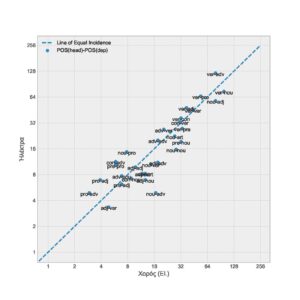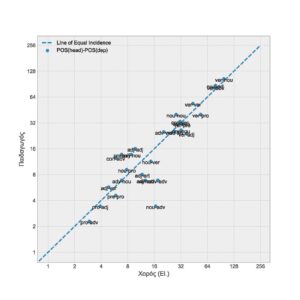1. Introduction
1.1 Computers, Literature, and Language
1.2 The Syntax of Characters

1.3 A Treebank of Sophocles
Since 2009, the Perseus Digital Library has maintained a treebank of Ancient Greek and Latin literary texts: The Ancient Greek and Latin Dependency Treebank (AGLDT, or AGDT for the Greek section only). [18] Five complete tragedies of Sophocles (Ajax, Electra, Oedipus Rex, Antigone, and Women of Trachis) are published in this collection and are freely available for browsing and downloading. Each word of these texts is annotated with the lemma and full morphological analysis, along with other metadata whose importance will be discussed later. [19] The syntax of the sentence is codified according to a form of Dependency Grammar, where words are attached directly to one another with no intermediate constituent, such as a noun or verb phrase, introduced; the relation between head and dependent is described with a label from a set of about twenty tags. A definition of the labels and the rules for syntactic annotations are defined in the project guidelines. [20] To simplify the matter, in many prototypical cases the formalism adopted reproduces some “intuitions” about the syntax that should be familiar to most classicists: a verb governs its satellites, like subjects, direct objects, and complements; equally, nouns are licensed to govern definite articles and adjectives that agree with them. [21]
| Nr. of Treebank Tokens | |||
| Work | Annotator | TOT | Artificial nodes |
| Ajax | D. Libatique | 9693 | 275 |
| Electra | F. Mambrini | 10808 | 316 |
| Oedipus Rex | F. Mambrini | 11523 | 337 |
| Trachiniae | F. Mambrini | 9028 | 206 |
| Antigone | F. Mambrini | 8993 | 240 |
| TOT | 50045 | 1374 | |
2 Methodology
2.1 In Search of the Speaking Character
2.2 Defining the Syntax
2.3 What Characters?
3. Patterns of Correlation
3.1 Pronouns and Prepositions by Electra and Oedipus

In the first scene of the second episode (see lines 450–496, in particular) and their most famous confrontation, we can argue that that syntactic feature is—together with the semantics of such loaded words as νόμοι, κήρυγμα, or νόμιμα—one of the linguistic elements that is widening the gulf between the two characters. In the 20 iambic trimeters of her speech (ll. 450–470), Antigone utters 7 first- and second-person personal pronouns, including one in her famous incipt: οὐ γάρ τί μοι Ζεὺς ἦν ὁ κηρύξας τάδε, “for it was not Zeus that had published me that edict,” (line 450 – transl. Jebb). The pronouns, especially of first-person, become increasingly frequent towards the center of the speech:
κεἰ μὴ σὺ προὐκήρυξας. εἰ δὲ τοῦ χρόνου
πρόσθεν θανοῦμαι, κέρδος αὔτ᾽ ἐγὼ λέγω.
ὅστις γὰρ ἐν πολλοῖσιν ὡς ἐγὼ κακοῖς
ζῇ, πῶς ὅδ᾽ οὐχὶ κατθανὼν κέρδος φέρει;
465 οὕτως ἔμοιγε τοῦδε τοῦ μόρου τυχεῖν
παρ᾽ οὐδὲν ἄλγος.
In comparison, only one ἐγώ is found in Creon’s answering speech (ἦ νῦν ἐγὼ μὲν οὐκ ἀνήρ, αὕτη δ᾿ ἀνήρ, “indeed, now I am no man, but she is a man,” line 484, transl. Lloyd-Jones), while the new king refers to Antigone only with the third-person pronoun αὐτή (also lines 480, 488). Nouns, on the other hands, are particularly abundant in his aphorisms, as is exemplified in the following passage:
πίπτειν μάλιστα, καὶ τὸν ἐγκρατέστατον
475 σίδηρον ὀπτὸν ἐκ πυρὸς περισκελῆ
θραυσθέντα καὶ ῥαγέντα πλεῖστ᾽ ἂν εἰσίδοις:
σμικρῷ χαλινῷ δ᾽ οἶδα τοὺς θυμουμένους
ἵππους καταρτυθέντας: οὐ γὰρ ἐκπέλει
φρονεῖν μέγ᾽ ὅστις δοῦλός ἐστι τῶν πέλας.
As we said, pronoun is a broad category that groups together different words. If one considers the lemmata of the pronouns governed by a preposition in Electra’s part, we see that the first- (8) and second-person (13) [37] pronouns are the most represented. This is not always the case. Iocaste, who at 10.05 ranks close to Electra’s 10.34 for the number of per-1000 occurrences of the construction, perhaps as an effect of her much lower number of total tokens (796 vs the 3870 of Electra), has a few second-person pronouns (3) but no first persons; the remaining five occurrences are divided between the relative ὅς (2), τις (2) and ὅδε (1).
| Character | Tot | Freq. x 1000 |
| Electra | 21 | 5.43 |
| Deianeira | 9 | 3.86 |
| Tecmessa | 5 | 3.97 |
| Chorus (OT) | 5 | 3.05 |
| Oedipus | 11 | 2.60 |
3.2 Lowest and Highest Correlations

The importance of noun-epithet couplets in the language of the Paedagogus is once again clear to everyone who reads the first lines of his (fake) report on Orestes’ death:
πρόσχημ᾽ ἀγῶνος Δελφικῶν ἄθλων χάριν,
ὅτ᾽ ᾔσθετ᾽ ἀνδρὸς ὀρθίων κηρυγμάτων
δρόμον προκηρύξαντος, οὗ πρώτη κρίσις,
685 εἰσῆλθε λαμπρός, πᾶσι τοῖς ἐκεῖ σέβας:
δρόμου δ᾽ ἰσώσας τῇ φύσει τὰ τέρματα
νίκης ἔχων ἐξῆλθε πάντιμον γέρας.
The style of this beginning is certainly very much in tune with the tale of the glorious but tragic death of a young athlete during a chariot race, which immediately evokes the precedents of epic and epinikian poetry. However, the long narrative of lines 680–764 is not the only passage where the Paedagogus displays a high number of “exornative epithets” coupled with nouns: the very beginning of the tragedy, where the Paedagogus addresses Orestes and describes the landscape of the Argolid for him, makes a no less prominent and abundant exhibition of noun-epithet couplets:
Ἀγαμέμνονος παῖ, νῦν ἐκεῖν᾽ ἔξεστί σοι
παρόντι λεύσσειν, ὧν πρόθυμος ἦσθ᾽ ἀεί.
τὸ γὰρ παλαιὸν Ἄργος οὑπόθεις τόδε,
5 τῆς οἰστροπλῆγος ἄλσος Ἰνάχου κόρης:
αὕτη δ᾽, Ὀρέστα, τοῦ λυκοκτόνου θεοῦ
ἀγορὰ Λύκειος: οὑξ ἀριστερᾶς δ᾽ ὅδε
Ἥρας ὁ κλεινὸς ναός: οἷ δ᾽ ἱκάνομεν,
φάσκειν Μυκήνας τὰς πολυχρύσους ὁρᾶν
10 πολύφθορόν τε δῶμα Πελοπιδῶν τόδε
3.3 Some Conclusions (and Future Plans)
References
Appendix
A.1 The top thirty POS-POS syntactic relations in the AGDT’s Sophocles
The raw frequency of the construction is reported in parenthesis:
A.2 Characters in Sophocles that speak more than 700 treebank tokens
Ajax
Electra
Oedipus Rex
Antigone
Women of Trachis
A.3 Full prospect of the correlation among characters
Ajax
Ajax:
LOW: Creon_OT (0.863); Chorus_Ant. (0.867); Chrysothemis (0.880).
Teucros:
LOW: Chorus_Ant (0.796); Chorus_Tr (0.897); Paedagogus (0.902).
Tecmessa:
LOW: Chorus_Ant (0.806); Paedagogus (0.908); Chorus_Tr (0.909).
Chorus_Aj:
LOW:Creon_OT (0.756); Chrysothemis (0.776); Clytaemestra (0.803).
Electra
Electra:
LOW:Chorus_Ant. (0.730); Paedagogus* (0.860); Chorus_Tr. (0.864).
Chorus_El:
LOW:Creon_OT (0.810); Clytaemestra* (0.824); Chrysothemis* (0.833).
Chrysothemis:
LOW:Chorus_Ant. (0.635); Chorus_Aj (0.776); Paedagogus* (0.787).
Orestes:
LOW:Chorus_Ant. (0.692); Chorus_Tr. (0.836); Chrous_Aj. (0.847).
Paedagogus:
LOW:Creon_OT (0.760); Clytaemestra* (0.786); Chrysothemis* (0.787).
Clytaemestra:
LOW:Chorus_Ant. (0.631); Paedagogus* (0.786); Chorus_Tr. (0.795).
Oedipus Rex
Oedipus:
LOW:Chorus_Ant. (0.662); Paedagogus (0.808); Chorus_Aj. (0.815).
Chorus_OT:
LOW:Creon_OT* (0.861); Chrysothemis (0.865); Clytaemestra (0.877).
Creon_OT:
LOW:Chorus_Ant. (0.611); Chorus_Aj. (0.756); Chorus_Tr. (0.758).
Iocaste:
LOW:Chorus_Ant. (0.726); Chorus_Tr. (0.839); Chorus_Aj. (0.851).
Antigone
Creon_Ant.
LOW:Chorus_Ant. (0.752); Chorus_Tr. (0.864); Chorus_Aj. (0.884).
Chorus_Ant.:
LOW:Creon_OT (0.611); Clytaemestra (0.631); Chrysothemis (0.635).
Antigone:
LOW:Chorus_Ant.* (0.742); Chorus_Aj. (0.855); Paedagogus (0.861).
Guard:
LOW:Chorus_Ant. (0.768); Clytaemestra (0.873); Chorus_Aj. (0.878).
Women of Trachis
Deianeira:
LOW:Chorus_Ant. (0.788); Chorus_Aj. (0.896); Chorus_Tr.* (0.900).
Heracles:
LOW:Creon_OT (0.853); Chorus_Ant. (0.871); Chrysothemis (0.874).
Hyllos:
LOW:Chorus_Ant. (0.787); Paedagogus (0.899); Chorus_Aj. (0.903).
Lichas:
LOW:Chorus_Ant. (0.804); Creon_OT (0.883); Clytaemestra (0.885).
